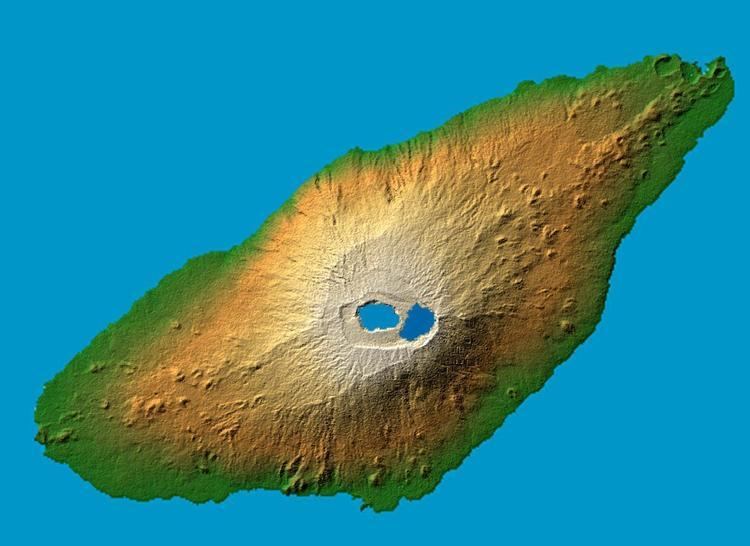Country Vanuatu Time zone VUT (UTC+11) Area 398 km² Province Penama Province | Highest elevation 1,496 m (4,908 ft) Elevation 1,496 m Population 10,407 (2009) Island group Islands of Vanuatu | |
 | ||
Aoba, also known as Ambae or Leper's Island, is an island in the South Pacific island nation of Vanuatu, located near 15°30′S 167°30′E.
Contents
- Map of Ambae Vanuatu
- History
- Geography
- Volcano
- Demographics
- Population
- Economy and agriculture
- Transportation
- References
Map of Ambae, Vanuatu
History
First recorded sighting by Europeans was by the Spanish expedition of Pedro Fernández de Quirós in the spring of 1606.
The misty sight of Ambae from neighbouring Espiritu Santo, which served as a major World War 2 airbase, inspired the mythical Bali Ha'i in James Michener's Tales of the South Pacific.
Geography
Rough, black basalt stones compose its shoreline and surface in many places, though the soils (where present) are rich. The island appears to be covered in nearly unbroken vegetation; inhabited areas feature large gardens and managed forests above, with coconut and cacao plantations usually closer to shore. There are no reliable sources of surface water (rivers, streams, or lakes), save the crater lakes which are inaccessible. Water for all human uses comes from cement-lined wells or water tanks filled with rainwater.
Volcano
Ambae is physically characterized by the large volcano at its center, Lombenben; indeed, the island is little more than the peak of a volcanic mountain rising dramatically from the sea. This volcano has no visible vents at its apex, only crater lakes. It is, nevertheless, active: a steam and ash eruption began on November 27, 2005, leading to a Level 2 volcano alert and preparations for evacuations. On December 8, the eruption became stronger, displacing around half of the island's roughly 10,000 inhabitants and requiring the evacuation of two hospitals.
Demographics
The population is Melanesian, though (anecdotally) ancient Polynesian admixtures have given Man-Ambae lighter complexions and Polynesian languages. Religiously Ambae is exclusively Christian, split into many denominations. These can be characterized in three stages: the original colonial-missionary churches (Anglican, Catholic), the second-stage, often American-origin evangelical denominations (Apostolic, Church of Christ, Assemblies of God), and the newer, less orthodox, fusion/'unity' sects. This last category includes many grass-roots groups originating within Vanuatu. Missionary activity from outside (as in all Vanuatu) continues, especially from Mormons, who have a growing following on West & North Ambae. The Seventh-day Adventists live on one side of the wall and the Catholics are on the other side.
Population
Ambae has a population of less than 11,000, divided into 3-4 discernible language groups (North/East Ambae language centered on the Lombaha area, West Ambae language centered on Nduindui, and South Ambae language centered on Redcliffe). The island has no considerable towns, though the Penama provincial center is located at Saratamata on East Ambae.
Economy and agriculture
The local economy is largely non-monetary, with cash crop income (from copra, cacao, and dried kava) being used primarily for school fees and sundry items like soap, salt, kerosene, etc. Most regular employment is in the public sector, as teachers. Remittances from employed relatives in the towns of Santo or Vila also contribute cash to the local economy.
Ambae is serviced by less than 100 telephone lines, mostly on the east side. It has two post offices and NBV bank branches, at Saratamata and Nduindui, regular interisland ship traffic, and several Vanair flights a week. Of the small-to-medium outer islands of Vanuatu (i.e., not Efate, Santo, Tanna or Malekula), Ambae must be considered one of the more 'developed.'
Traditional subsistence agriculture satisfies food needs, while most villagers engage in small-scale cash crop production as well. Often grown in large upland gardens (with good rainfall and safe from roving pigs), the primary crops are taro, banana, yam, and manioc. Kumala (sweet potatoes - a good tuber thereof is called iggeremanggeggeuni ), vegetables, fruits and nuts help to provide an excellent diet, though protein is occasionally lacking. Without substantial reefs, seafood is less significant a protein source compared with other islands of Vanuatu and in any case is inaccessible to the large populations living at high inland elevations.
Transportation
The island is served by three airstrips with services by Air Vanuatu: Walaha Airport in the southwest, Redcliffe Airport in the south and Longana Airport in the northeast.
